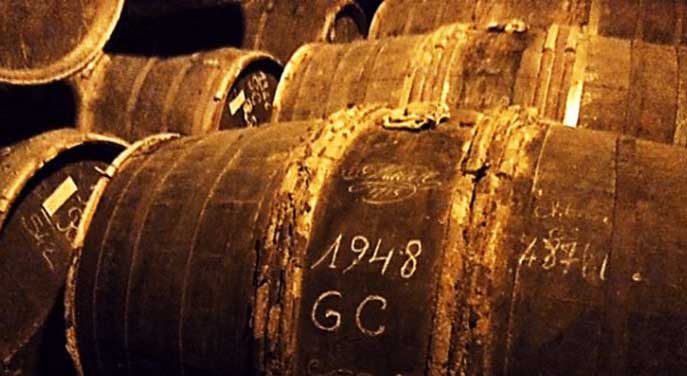 Augier, the first modern cognac house, was organized in 1643. Today the brand is owned by French spirits giant Pernod Ricard. It recently relaunched the brand with a line of cognacs said to reflect the early style of the product.
Augier, the first modern cognac house, was organized in 1643. Today the brand is owned by French spirits giant Pernod Ricard. It recently relaunched the brand with a line of cognacs said to reflect the early style of the product.
Over the two centuries following 1643, many of the leading cognac houses, including the big four that today dominate the market, emerged: Martell (1715), Rémy Martin (1724), Hennessy (1765) and Courvoisier (1809). Today, there are 274 cognac houses, drawing from 4,500 grower-distillers, producing around 1,000 brands of cognac, including custom retailer-specific ones.
The 19th century proved to be a boom time for cognac, even if the precise character of the spirit would not be defined until the next century.
In 1775, France exported 47,700 hectolitres of cognac (1.240 million gallons). By 1860, exports had tripled to 149,000 hectolitres (3.875 million gallons).
Following the signing in 1860 of the Cobden-Chevalier Treaty, which created free trade between Great Britain and France, exports jumped to 245,000 hectolitres (6.344 million gallons), then to 478,000 hectolitres (12.43 million gallons) in 1879. At its peak, more than 700,000 acres of vineyards were devoted to cognac production.
A catastrophe, however, was just around the corner. Starting in the mid-19th century, European wine growers were struck by two successive plagues of grape disease that originated in the United States: powdery mildew and downy mildew. Then, in 1870, they were joined by a third deadly scourge: phylloxera.
 One of the unforeseen consequences of the emergence of steam-driven ships was that the passage across the Atlantic was now fast enough that pests, which historically would have died en route, could now survive the voyage.
One of the unforeseen consequences of the emergence of steam-driven ships was that the passage across the Atlantic was now fast enough that pests, which historically would have died en route, could now survive the voyage.
One such pest was the phylloxera aphid (phylloxera vastatrix). The vine louse, as it was called, fed on the roots of grape plants, cutting off the supply of nutrients and water, creating openings that could be infected by fungi and bacteria.
European grape varieties, unlike native U.S. grapes, had no defence. Over three decades, roughly 80 per cent of Europe’s vineyards were destroyed. In the Charente, by 1893, the area under grape cultivation was around 100,000 acres, a reduction of 86 per cent.
The Charente was particularly hard hit. The solution to phylloxera – grafting European grape varieties to American grape root stocks that had natural immunity – took longer to implement in that area because the rootstocks of the American grape varieties tested didn’t adapt well to the region’s chalky soils.
Finally, a root stock variety (vitis berlandieri) was identified that could grow in the Charente’s chalky soils. Even then, it was only a partial solution. The region’s traditional grape varieties, Colombard and the highly aromatic Folle Blanche didn’t graft well with that root stock. In the case of Folle Blanche, the vines produced an abundance of tight grape clusters that were prone to rot.
Another grape variety, Ugni blanc, had been growing in popularity because of its natural resistance to downy mildew and powdery mildew, as well as its high yields. It took readily to the American root stock.
When cognac’s vineyards were replanted, they were done so primarily with Ugni blanc. Folle Blanche all but disappeared. Today, 98 per cent of the grapes grown for cognac production are Ugni blanc.
Phylloxera can’t tolerate sandy soils. The vineyards along the Atlantic coast were better able to withstand the onslaught of the grape louse. For a while, the traditional grape varieties continued to be grown on their own root stocks. But they gradually died out.
There are still patches of ancient vineyards of Folle blanche and Colombard along the coast of Charente-Maritime. Chateau de Beaulon, for example, still produces a seven-year-old 100 per cent Folle blanche cognac from the sandy soils of the Fin Bois.
The effects of phylloxera were far-reaching. For the better part of two decades, cognac production virtually shut down. Prices soared and what had always been an expensive luxury became almost unreachable for many consumers.
The crisis came just as the Scotch whisky industry was hitting its stride. The Scots were quick to seize the opportunity. Scotch whisky exports to France and elsewhere skyrocketed.
Even today, France is the Scotch whisky industry’s largest market by volume, although not be revenue. The French took to whisky with a passion. Almost a century and a half after the phylloxera crisis, France still consumes more Scotch whisky in a week than it does cognac in a year. The same development played out in England, where cognac had historically been more popular than whisky.
The lack of supply also spurred widespread counterfeiting. In response, in 1909, the French government delineated, by official decree, the boundaries that marked the region where cognac could be produced.
For a brandy to be called cognac, it had to be distilled within the defined region, although it didn’t need to be aged there. Brandy could still be produced outside the region, but it couldn’t carry the cognac designation. Criminal penalties for fraudulent activities were added in 1919.
In 1935, the production process was codified, including the requirement of double distillation and the size, shape and configuration of the distillation equipment.
The next year, the permitted grape varieties were also set out: Colombard, Folle blanche, Jurançon blanc, Meslier-Saint-François, Montils, Sémillon or Ugni blanc, and up to 10 per cent Folignan or Sélect. But by then, virtually all the production was based on Ugni blanc.
In 1936, cognac was recognized as an Appellation d’Origine Controlee (AOC). For the most part, the new AOC corresponded with the traditional cognac producing zone. Two years later, based on the original geologic surveys of French geologist Henri Coquand, the AOC was broken down into six additional crus, five geographic and one based on the specifics of the blend.
The five geographic crus were Grande Champagne, Petit Champagne, Borderies, Fin Bois and Bon Bois. The sixth geographic crus, Bois Ordinaire, was added later. Fine champagne is a designation based on a blend of spirits drawn from Grande Champagne and Petit Champagne, where at least 50 per cent of the spirit is from Grande Champagne.
By 1938, the organization of the modern cognac industry was complete. Cognac had rebounded from the devastation of phylloxera and successfully weathered the First World War, American prohibition and the Great Depression. The Second World War still lay ahead, however, and production levels were still far below their peak.
By the 1970s, however, almost a century after phylloxera first devastated the Charente region, production had doubled, even though the amount of producing vineyard land was still half of its 19th-century peak.
Since then, cognac has gone from strength to strength. In 2016, sales rose to 179 million bottles, with a total export value of around €3 billion or US$3.6 billion; approximately $10 billion at retail. Worldwide, cognac represents about 1.5 per cent of spirit sales by volume but 4.5 per cent by revenue.
Despite its dramatic rebound, however, the cognac industry has never regained the dominant market position it enjoyed in the 19th century.
Next: Understanding cognac: It’s all about Terroir
Joseph V. Micallef is an historian, best-selling author, keynote speaker and commentator on wine and spirits. Joe holds the Diploma in Wine and Spirits and the Professional Certificate in Spirits from the Wine and Spirits Education Trust (London).
Joseph is a Troy Media Thought Leader. For interview requests, click here.
The views, opinions and positions expressed by columnists and contributors are the authors’ alone. They do not inherently or expressly reflect the views, opinions and/or positions of our publication.
© Troy Media
Troy Media is an editorial content provider to media outlets and its own hosted community news outlets across Canada.

